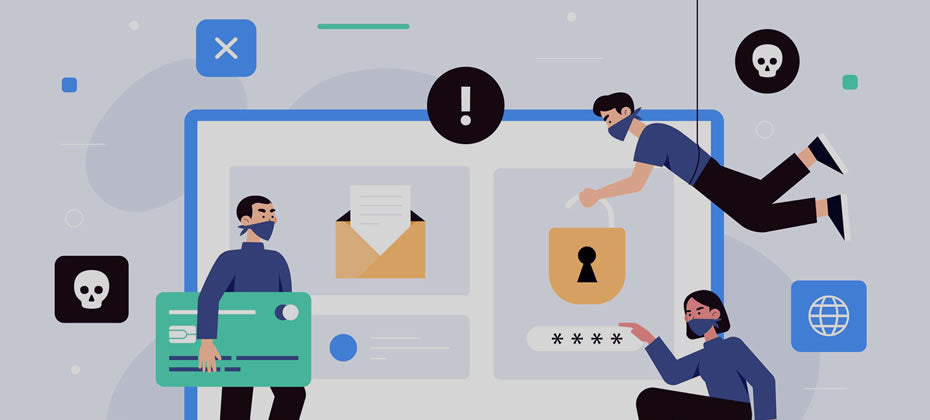In today's digital age, online security has become paramount, especially when it comes to protecting your personal information and financial assets. One of the most prevalent threats on the internet is phishing attacks. These deceptive attempts to steal your sensitive data, such as login credentials, credit card numbers, and personal information, can occur through emails, social media, or websites. Unfortunately, even reputable companies like ours are not immune to impersonation by cybercriminals. In this article, we'll guide you on how to recognize and defend against phishing sites, how to report them, and what to do if you fall victim to such scams.
Recognizing Phishing Sites
Phishing sites are cunningly designed to mimic trusted organizations, making them appear genuine at first glance. However, by paying attention to the following red flags, you can reduce the risk of falling victim to these scams. Let's get into it.
Check the URL: Examine the website's URL carefully. Phishing sites often use misspelled, slightly altered domain names or even different domain extensions. Make sure you are on the correct official website, and look for "https://" in the URL, indicating a secure connection. For example, if you do not see the domain name "trovelle.com" in the address bar as the domain name, then leave the site immediately.
Trovelle.com is only official domain name for our company.
Here is an example of a phishing website we reported and shut down:
Notice the following:
- Company logo is missing.
- Website icon in the browser is actually a WordPress logo.
- The main navigation does not make logical sense.
- Website looks unprofessional.
- Currency formatting is from a non-U.S. region.
- Prices are heavily discounted to lure shoppers.
- There isn't a physical address or phone number.
- Some payment methods advertised were not available in checkout.
The list really goes on and on.
Verify the website's design and content: Phishing sites may have poorly designed or inconsistent layouts, blurry images, or grammatical errors in their content. Genuine websites typically maintain a professional appearance.
Major price discounts: Phishing websites will clone website content and product pages from real websites and dramatically discount the prices. They lure victims this way with no intention to fulfil or ship orders, since they do not have the physical product.
Beware of urgent requests: Phishing emails or websites often create a sense of urgency, pressuring you to take immediate action. Be cautious when you receive unexpected emails or messages requesting personal information or payment details.
Check for official contact information: Legitimate organizations provide clear contact information on their websites. If you cannot find a verifiable physical address, phone number, or email contact, it may be a phishing attempt.
Hover over links: Before clicking on any links, hover your cursor over them to preview the destination URL in the browser's status bar. Ensure it matches the official website's domain.
Defending Against Phishing Attacks
To protect yourself from falling victim to phishing sites that pretend to be us or any other legitimate organization, follow these best practices:
Educate Yourself: Stay informed about phishing tactics and the latest scams. Awareness is your first line of defense.
Use Reliable Security Software: Install and regularly update antivirus and anti-malware software to help identify and block known phishing attempts.
Enable Two-Factor Authentication (2FA): Whenever possible, enable 2FA on your accounts, especially email and financial accounts. This extra layer of security can prevent unauthorized access even if your login credentials are compromised.
Keep Software and Devices Updated: Ensure your operating system, web browsers, and applications are up-to-date with the latest security patches.
Exercise Caution with Emails: Be wary of unsolicited emails, especially those asking for personal information, passwords, or financial details. Verify the sender's legitimacy before responding.
Report Suspicious Activity: If you suspect a phishing attempt, report it to the legitimate organization and relevant authorities immediately. Both Google and Microsoft offer ways to report suspicious website.
Reporting Phishing Sites
Reporting phishing sites is crucial in the fight against cybercrime. If you come across a phishing site pretending to be our company, reach out to our customer support immediately to inform us of the phishing attempt. We will take immediate action to mitigate the situation and protect other customers.
In addition, most web browsers have built-in tools for reporting phishing sites. Use these features to alert the browser developers, who can warn other users.
How We Deal With Phishing Websites
When we become aware of any phishing websites pretending to be us, we immediately report them to their domain registrar, hosting provider, and any other service provider they use including payment processors. In addition, we report them to major browser developers and search engines. We may also report them to law enforcement and pursue legal recourse.
What to Do If You Fall Victim
Despite your best efforts, it's still possible to fall victim to a phishing attack. If this happens:
Change Your Passwords: Immediately change the passwords for any accounts that may have been compromised.
Contact Financial Institutions: If you provided financial information, contact your bank or credit card company to report the incident and take necessary steps to secure your accounts.
Monitor Your Accounts: Regularly monitor your financial and online accounts for any unauthorized activity.
Consider Identity Theft Protection: If you shared sensitive personal information, consider signing up for an identity theft protection service.
Remember, your safety and security online are paramount. By staying vigilant and following these guidelines, you can protect yourself from falling victim to phishing attempts.


















